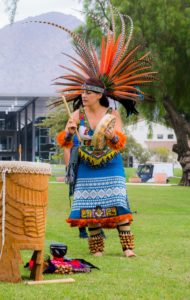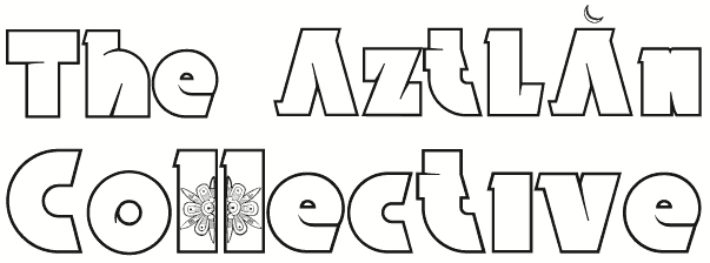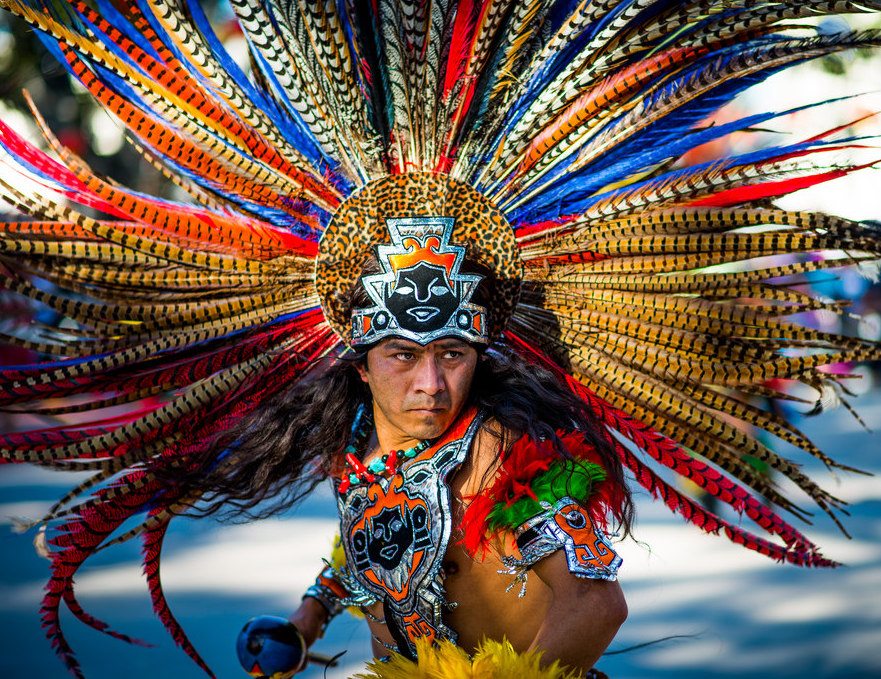Adapted from the paper, Dancing Amoxtli: Danza Azteca and Indigenous Body Art as Forms of Resistance from 2012 by Veronica X. ValaDez
The history of European oppression that Xicanxs have inherited begins with the Spanish conquest and colonization of the indigenous populations of Mexico, followed by the annexation of over half of Mexico’s territory after the US/Mexican war of 1848 (Gómez 89). Sociologist, Laura E. Gomez’s critical race study of the hypodescent rule, links the notion of Manifest Destiny to the American colonization of northern Mexico and urges us to take seriously what she has termed the “double colonization” of the American Southwest (89). Gómez explains that this region was colonized twice, first by Spain and then by the United States. She further argues that both the Spanish and the American colonial experiences were grounded in racism – “in a system of status inequality built on presumed racial difference” (89).
The violent occurrence of colonization threatened the existence of core elements of indigenous cultures including language, traditions, religion, forms of government, native spirituality, and systems of knowledge (Fanon 6; León-Portilla, Aztec Thought 69; McCarty 2; Smith 69). This experience has formed a wedge and disconnection between Xicanxs and their indigenous roots that have reinforced the ongoing colonization of the Xicanx community. Frantz Fanon explains that, “National culture under colonial domination is a culture under interrogation whose destruction is sought out systematically” (171). He also points out that the systematic negation of the “other” is done so in order to deny the “other” any attribute of humanity, which forces the colonized to constantly ask the question “Who am I in reality?” (182).
 It can be difficult for Xicanxs to completely develop their identities without acquiring accurate histories of their indigenous past or understanding their ancestors’ systems of knowledge (McCarty 3). According to Peter McLaren, “certain types of [Western] knowledge are used to reinforce dominant ideologies, which in turn serve to mask unjust power relations among certain groups in society” (64). From the perspective of critical educational theorists, the curriculum in mainstream schools represents much more than a program of study, a classroom text, or a course syllabus (McCarty 3; McLaren 49; Smith 33). Rather, it represents the introduction to a particular form of life; it serves in part to prepare students for dominant or subordinate positions in the existing society (McLaren 64). McLaren urges us to “recognize and redress the discursive conditions under which women, minorities, and other groups are demonized by patriarchy and the social relations of capital so that their presence as racial, cultural, and gendered subjects is effectively struck out of the archives and current narratives of history” (65). By being disconnected from their own histories and indigenous systems of knowledge, Xicanxs will continue to be dependent on a system that keeps them oppressed and from becoming self-sufficient. To counter this, Xicanxs must tap into alternative histories and indigenous epistemologies.
It can be difficult for Xicanxs to completely develop their identities without acquiring accurate histories of their indigenous past or understanding their ancestors’ systems of knowledge (McCarty 3). According to Peter McLaren, “certain types of [Western] knowledge are used to reinforce dominant ideologies, which in turn serve to mask unjust power relations among certain groups in society” (64). From the perspective of critical educational theorists, the curriculum in mainstream schools represents much more than a program of study, a classroom text, or a course syllabus (McCarty 3; McLaren 49; Smith 33). Rather, it represents the introduction to a particular form of life; it serves in part to prepare students for dominant or subordinate positions in the existing society (McLaren 64). McLaren urges us to “recognize and redress the discursive conditions under which women, minorities, and other groups are demonized by patriarchy and the social relations of capital so that their presence as racial, cultural, and gendered subjects is effectively struck out of the archives and current narratives of history” (65). By being disconnected from their own histories and indigenous systems of knowledge, Xicanxs will continue to be dependent on a system that keeps them oppressed and from becoming self-sufficient. To counter this, Xicanxs must tap into alternative histories and indigenous epistemologies.
 Discriminatory social models created to keep minorities in subordinate positions, stimulate various forms of resistance to develop by those who are oppressed (McLaren 64). Often, forms of resistance have negative effects on the community. For example, marginalized students may resist mainstream education within the school system by challenging the teacher, by not doing their homework, or by misbehaving in class (64). Because students do not connect with school curriculum, they may resort to random acts of violence and refuse to learn at all (64). This behavior can have a devastating outcome in the educational experiences of students with dire consequences affecting their futures.
Discriminatory social models created to keep minorities in subordinate positions, stimulate various forms of resistance to develop by those who are oppressed (McLaren 64). Often, forms of resistance have negative effects on the community. For example, marginalized students may resist mainstream education within the school system by challenging the teacher, by not doing their homework, or by misbehaving in class (64). Because students do not connect with school curriculum, they may resort to random acts of violence and refuse to learn at all (64). This behavior can have a devastating outcome in the educational experiences of students with dire consequences affecting their futures.
Resisting mainstream education can help individuals cope and function in society rather than to become overwhelmed by feelings of complete hopelessness (Kohl 29). For others, this act of resistance can eventually lead to them being categorized, stigmatized, and even institutionalized and punished (29). Regrettably, communities are negatively impacted as a consequence of the Xicanxs’ resistance towards learning and doing well in school, which leads to high dropout rates, poverty, substance abuse, and gang violence. However, some forms of resistance can have a powerful and positive impact on individuals and groups of people. Educator, Herbert Kohl argues, “In times of social movements for justice, such refusal (of dominant schooling) is often turned into more positive mass protests and demonstrations, and to the development of alternative learning situations” (29). Thus, I propose that one way in which Xicanxs can resist the effects of colonialism, is by utilizing indigenous ways of learning, such as Danza Azteca, as pathways that can offer alternative ways of regaining indigenous epistemologies and establishing a renewed indigenous perspective of life, history, identity, and culture.
 Indigenous cultural traditions are sometimes used to elaborate political agendas and identity formations by Xicanxs (Contreras 77). Today, as in the past, the spiritual, creative and political resources that indigenous peoples draw from one other provide alternatives for our communities. Linda T. Smith argues, “While the indigenous movement is encapsulated within the politics of self-determination, it also involves a revitalization and reformation of culture and tradition, as well as an increased participation in the rejection of Western ideologies” (110). Although it is not critical for Xicanxs to identify themselves as descendants of indigenous people in order to develop healthy identities, reconnecting to their native cultural roots can have a strong influence on the Xicanx’s path towards decolonization and empowerment.
Indigenous cultural traditions are sometimes used to elaborate political agendas and identity formations by Xicanxs (Contreras 77). Today, as in the past, the spiritual, creative and political resources that indigenous peoples draw from one other provide alternatives for our communities. Linda T. Smith argues, “While the indigenous movement is encapsulated within the politics of self-determination, it also involves a revitalization and reformation of culture and tradition, as well as an increased participation in the rejection of Western ideologies” (110). Although it is not critical for Xicanxs to identify themselves as descendants of indigenous people in order to develop healthy identities, reconnecting to their native cultural roots can have a strong influence on the Xicanx’s path towards decolonization and empowerment.
For example, Danza Azteca, a traditional and spiritual art form that survived colonization, allows Xicanxs to explore and determine their indigenous identities. This identification as native people also prompts us to reexamine and reimagine our indigenous histories and cultural roots. These are all powerful and positive forms of resistance that are imperative for the Xicanx community to conceive, nurture, and establish a decolonial imaginary while striving for a postcolonial reality.

Works cited:
Contreras, Sheila M. Blood Lines: Myth, Indigenism, and Chicana/o Literature. Austin: University of Texas, 2008. Print.
Fanon, Frantz, and Richard Philcox. The Wretched of the Earth. New York: Grove, 2004. Print.
Gómez, Laura E. “Opposite One-Drop Rules: Mexican Americans, African Americans, and the need to Reconceive Turn-of-the-Twentieth-Centura Race relations.” In How the United States Racializes Latinos: White Hegemony and Its Consequences. Paradigm Publishers, 2009. 87-100. Print.
Kohl, Herbert R. I Won’t Learn from You: And Other Thoughts on Creative Maladjustment. New York, NY: New, 1994. Print.
León-Portilla, Miguel. Aztec Thought and Culture: a Study of the Ancient Nahuatl Mind. Vol. 67. Norman: University of Oklahoma, 1990. Print.
McCarty, Teresa L. “Indigenous Epistemologies and Education Self-Determination, Anthropology, and Human Rights.” Anthropology Education Quarterly 36.1 (2005): 1-7. Print.
McLaren, Peter. Critical Pedagogy and Predatory Culture: Oppositional Politics in a Postmodern Era. London: Routledge, 1995. Print.
Smith, Linda Tuhiwai. Decolonizing Methodologies: Research and Indigenous Peoples. London: Zed, 1999. Print.
About the Author:
Veronica X. Valadez, M.A. is a visual artist, dancer, and educator based in Ventura, California. She completed her master’s thesis on Danza Azteca in 2012 and continues to advocate for its inclusion in ethnic studies programs. Visit the author’s website here.
To read more about the Ethnic Studies Now Coalition, visit the website.
Expert bios:
Shelia Marie Contreras is an Associate Professor at Michigan State University, where she teaches American Studies and Chicano/Latino Studies.
Frantz Fanon is a distinguished psychiatrist from Martinique who took part in the Algerian Nationalist Movement, and was one of the most important theorists of revolutionary struggle, colonialism, and racial difference in history. The Wretched of the Earth is a brilliant analysis of the psychology of the colonized and their path to liberation. The Wretched of the Earth has had a major impact on civil rights, anticolonialism, and black consciousness movements around the world, and this bold new translation by Richard Philcox reaffirms it as a landmark.
Laura E. Gómez is the president of the Law and Society Association and a Professor of Law and American Studies at the University of New Mexico.
Herbert R. Kohl is an educator best known for his advocacy of progressive alternative education and as the author of more than thirty books on education. He founded the 1960s Open School movement and is credited with coining the term “open classroom.”
Miguel León-Portilla is a Mexican anthropologist and historian, and a prime authority on Nahuatl thought and literature.
Teresa L. McCarty is the Alice Wiley Snell Professor of Education Policy Studies, Professor of Applied Linguistics, and Co-director of the Center for Indian Education at Arizona State University. An educational anthropologist, she has been a curriculum developer, teacher, and coordinator of American Indian education programs at the state and national levels.
Peter McLaren is Distinguished Professor of Critical Studies, College of Educational Studies, Chapman University, where he is Co-Director of the Paulo Freire Democratic Project and International Ambassador for Global Ethics and Social Justice.
Linda Tuhiwai Te Rina Smith is a professor of indigenous education at the University of Waikato in Hamilton, New Zealand.

